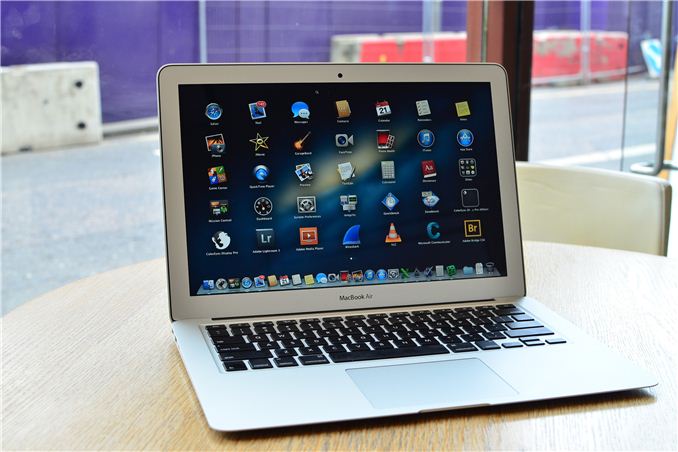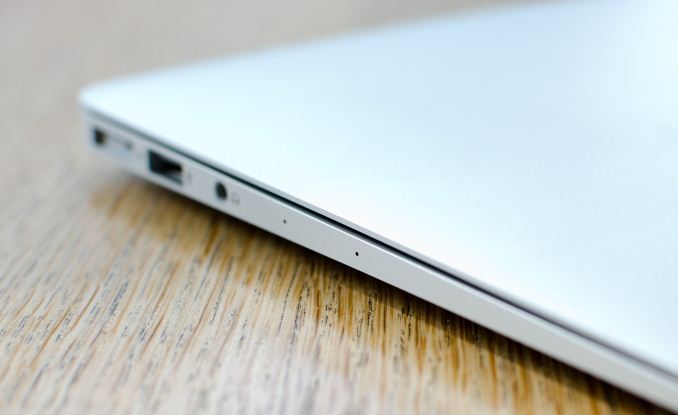The 2013 MacBook Air Review (13-inch)
by Anand Lal Shimpi on June 24, 2013 12:01 AM EST
Things didn’t go exactly as I’d expected at WWDC. I spent the week before the show at Computex, talking to PC OEMs, who had all just launched their Haswell ULT based Ultrabooks. With a couple of exceptions however, the bulk of Haswell ULT systems weren’t scheduled to ship until later this year. Even the Acer S7 I snagged while in Taipei was still a pre-production unit, with final hardware due out in the next month. Based on what I saw in Taiwan, and Intel having seeded me an Iris Pro machine the week before, I assumed that the MacBook Pro with Retina Display is what would get the Haswell treatment first. Obviously, that didn’t happen.
In hindsight, the move makes sense. Apple will sell far more MacBook Airs than rMBPs. The Apple/Intel relationship is looking very healthy these days, so it’s also not surprising that it would have supply and early enough access to Haswell ULT to launch the MBAs at WWDC with almost immediate availability. The Haswell ULT shift didn’t require a new chassis for Apple, which meant a less complex development process.
From the outside, the new MacBook Air looks nearly identical to its predecessor. There's a second mic opening on the left side of the machine now, but otherwise you'd be hard pressed to tell this year's model apart from the previous generation. Internally, nearly everything has changed.
The battery is higher capacity, with no increase in weight. Making better use of that larger battery is Intel's new Haswell ULT silicon. Since we're talking about a ULT part, the PCH moves from the motherboard to the CPU package - creating an emptier motherboard than we've seen in previous years:
The 2013 13-inch MacBook Air Motherboard, Courtesy iFixit
It's clear to me that the MBA is due for a more significant redesign, but this is not the year for that.
Alongside Haswell comes a brand new PCIe SSD, 802.11ac support and LPDDR3 memory. All at a price equal to, if not less than last year's models:
| 2013 MacBook Air Lineup | ||||||
| 11.6-inch | 11.6-inch (high-end) | 13.3-inch | 13.3-inch (high-end) | |||
| Dimensions |
H: 0.11-0.68" (0.3-1.7cm)
W: 11.8" (30cm) D: 7.56" (19.2cm) |
H: 0.11-0.68" (0.3-1.7cm)
W: 12.8" (32.5cm) D: 8.94" (22.7cm) |
||||
| Weight | 2.38 lbs (1.08kg) | 2.96 lbs (1.35kg) | ||||
| CPU | 1.3GHz dual-core Core i5 | 1.3GHz dual-core Core i5 | ||||
| GPU | Intel HD 5000 | |||||
| RAM | 4GB LPDDR3-1600 | |||||
| SSD | 128GB PCIe SSD | 256GB PCIe SSD | 128GB PCIe SSD | 256GB PCIe SSD | ||
| Display Resolution | 1366 x 768 | 1440 x 900 | ||||
| Ports | Thunderbolt, 2x USB 3.0, headphone jack | Thunderbolt, 2x USB 3.0, SD card slot, headphone jack | ||||
| Networking | 2x2:2 802.11ac | 2x2:2 802.11ac | ||||
| Battery | 38 Wh | 54 Wh | ||||
| Price | $999 | $1199 | $1099 | $1299 | ||
We've been over the MacBook Air chassis thoroughly in the past so I won't go through it again here. Build quality remains excellent. The clickpad and backlit keyboard never give me any troubles either. It's sad that we're still having clickpad issues elsewhere in ultraportables but this is one area where Apple's vertically integrated advantage is apparent (as is the company's willingness to spend a little extra on even the little details).
The only thing that hasn't changed, that perhaps should have is the display. The MacBook Air retains the same 1366 x 768/1440 x 900 panels from last year, while much of the competition has moved to at least 1080p IPS in the 13.3-inch form factor. This year at Computex we saw a number of systems move to 2560 x 1440 13.3-inch panels, at least as an option, however I'm expecting those systems to be priced more in line with the 13-inch rMBP rather than the MacBook Air. Admittedly, I don't know the right solution here.Ultra high resolution panels drive cost and power consumption up, the latter which can be offset by going to a larger battery - but then you have a 13-inch rMBP. Perhaps the right move for the MacBook Air would be for Apple to move to IPS panels at least? Or maybe we see a merger of the 13-inch MBA/rMBP, and something new entirely replace the 11-inch model.












233 Comments
View All Comments
vol7ron - Wednesday, June 26, 2013 - link
I'm sorry, have you ever owned an MBA? You don't want to be doing any heavy development on this device, it will get hot fast.This device should be the Traveler's Laptop: good enough to carry with you, more productive than an iPad, full keyboard, longer battery life than a regular laptop, lighter weight, and a few ports to maybe support what you need. It would be perfect for a plane or train, maybe to lounge by the pool, but should not be considered as a desktop or MBP replacement.
The shame of it is that it's so portable, that it leaves you wanting to do more with it. It almost has done it's job too well. In that regard, you are right, it is lacking the things that would put it over the edge, that would make it a replacement of the desktop/MBP, which again it's not. But be conscious that [I think] this has no fans, and from when I used it, got hot really fast -- horrible for any extreme development, or even long-term gaming.
darwinosx - Monday, July 8, 2013 - link
Hah! Lots of developers use Airs without issue.cscordo - Thursday, August 8, 2013 - link
What a ridiculous comment from someone who clearly doesn't develop software.I'm still on a 13" MBA from two gens ago and run multiple IDE's and SQL Server 2010, and it doesn't skip a beat.
What type of "heavy" software development do you perform that it can't handle? I'd be very interested to know.
josef195 - Tuesday, August 20, 2013 - link
So, you're saying the Macbook Air isn't for pro users? I must say, if only they had some Macbook for professional users; they could even call it a Macbook Pro.Calista - Thursday, June 27, 2013 - link
I agree with your ideas of adding the option of 16 GB of RAM and 4G support. Virtualization is growing all the time, the memory usage can grow very quickly if starting to run a few VM in parallel. And not having the option of 4G in this day and age is just embarrassing. For a machine *built* to be used on the go, with every component (battery life, weight, size) adopted to this task not adding 3G/4G just doesn't make sense.Dave DeCo - Saturday, June 29, 2013 - link
I have never given much thought to the 4G thing. But now that it's brought up I too wonder why the MBA doesn't offer it. My incredibly portable iPad has it. iPhone too of course. Why not the wafer thin MacBook Air? Oh Apple. Always dangling that carrot on the longest stick possible while telling us we don't need carrots. If that last line makes sense to anyone please tell me. Because I don't know what the Helsinki I just said.australianm8 - Saturday, July 6, 2013 - link
A few considerations for everyone fussing about 4g support.1. Apple likes to keep a simple product line
2. Look at a teardown, not much room in there for much more to add. (already pushing it's thermal limits)
3. There are a plethora of cell carriers that offer 4g USB sticks
darwinosx - Monday, July 8, 2013 - link
That was a childish and ignorant display of petulance. Obviously a particularly immature teenager.jaycee1970 - Saturday, August 24, 2013 - link
"Dump your apple stock now, it will bounce back"Wow, that's fantastic financial advice, genius. I'll definitely sell something that will go up in value. The rest of your post was just as intelligent. Thank you.
othernet - Monday, November 4, 2013 - link
Uhm... there are hybrid notebook/tablets out there. Did you buy one? I don't know of anyone that did.Apple sells Retina 4, 10, 13 and 15 inch products. Soon, an 8 inch product too. You must have missed the keynotes.
Wireless charging? Wait, do you still need to plug the wireless charger somewhere to make it work? When it doesn't have to sign me up!